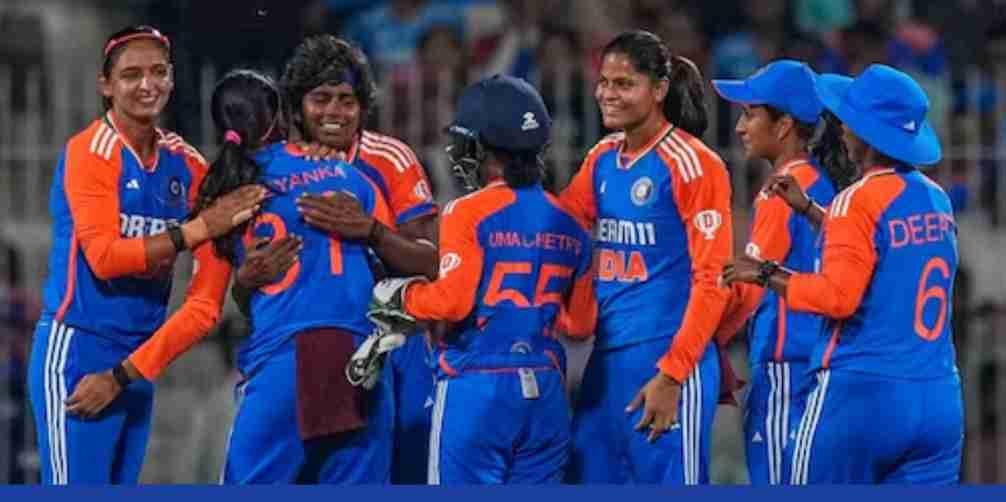Copyright dailyexcelsior

Swati Suman swatisuman1106@gmail.com On the cool November evening of 2nd November 2025, history was made at Mumbai’s D.Y. Patil Stadium. The Indian women’s cricket team lifted the ICC Women’s ODI World Cup trophy for the very first time, defeating South Africa by 52 runs. Tears of pride glistened in the players’ eyes as chants of “Bharat Mata ki Jai!” filled the air. This was more than a sporting triumph. It was a seal of recognition on a decades-long journey that took Indian women’s cricket from being “unnoticed” to “unforgettable.” When Smriti Swung, a Nation Watched When Smriti Mandhana leans into her signature cover drive or when Harmanpreet Kaur walks in to bat with that unmistakable fire in her eyes, something profound stirs across Indian cricket. For a long time, women’s cricket existed in the quiet margins, overshadowed by the men’s game, underfunded, and under-watched. Today, it stands illuminated under stadium lights, commanding the kind of attention once thought impossible. This transformation- slow, steady, and hard-earned- tells a larger story of how India began to see, support, and celebrate its women in sport. The Forgotten Beginning The roots of women’s cricket in India trace back to 1973, when the Women’s Cricket Association of India (WCAI) was formed in Lucknow. It was a bold initiative at a time when the very idea of women playing competitive cricket was met with disbelief. India played its first Test match in 1976 and even hosted the Women’s World Cup in 1978 l. five years before the men’s team claimed its first world title in 1983. Yet, despite these early milestones, progress was painfully slow. Matches were sparsely attended, coverage nearly non-existent, and players often travelled in unreserved train compartments, stitching their own kits. Financial aid was minimal, media recognition negligible. For decades, women played for passion, not pay. Their victories rarely made headlines, and their struggles remained unseen. But within those silences, a quiet determination grew a belief that their day would come. That day began to take shape in the mid-2010s. When the Board of Control for Cricket in India (BCCI) formally absorbed the WCAI in 2006, the sport finally gained administrative backing. Central contracts were introduced, exposure tours increased, and international fixtures became more regular. The real turning point, however, came with television and digital streaming. Once the matches were broadcast live, India’s women cricketers entered living rooms and hearts. Suddenly, the faces behind the scores had names, and those names had stories. By the time the 2017 Women’s World Cup arrived, Indian fans witnessed something unforgettable, Harmanpreet Kaur’s unbeaten 171 against Australia in the semifinal. It was more than a knock; it was a declaration that Indian women could dominate with the same power and flair as any men’s team. That innings marked the moment India’s women’s cricket truly arrived. The Icons of a New Era At the heart of this transformation stand two icons Smriti Mandhana and Harmanpreet Kaur. Mandhana, elegant and composed, represents the refined face of the new India confident, articulate, and grounded in excellence. Her cover drive has become a national metaphor for grace under pressure. Beyond her centuries and rankings lies her true contribution: she made young girls believe cricket could be their dream too. Harmanpreet, by contrast, embodies sheer power and purpose. As captain, her leadership blends aggression with empathy, her celebrations are fierce yet authentic. She commands respect through action, not authority. From steering ODIs to shaping T20 cricket, she has personified resilience and reinvention. Together, they form the two halves of Indian cricket’s new heartbeat. Mandhana’s grace and Harmanpreet’s grit. From Stadiums to Screens- The Game Changes Forever The launch of the Women’s Premier League (WPL) in 2023 was nothing short of revolutionary. With franchises bidding crores, international players participating, and matches telecast in prime time, women’s cricket was no longer an afterthought, it was a phenomenon. The 2025 ICC Women’s World Cup, co-hosted by India and Sri Lanka, only amplified this momentum. Record-breaking digital viewership and packed stadiums reflected a new cultural shift. The India–Pakistan encounter drew some of the highest global streaming numbers, underscoring that the world was finally watching. What was once a footnote in sports bulletins is now front-page news. The women’s game is not just watched, it’s awaited. Beyond the Numbers: A Social Movement in Motion Cricket in India has never been just a sport, it’s been an identity, a shared language. When women stepped onto that same turf, they weren’t only competing for runs and wickets; they were reclaiming space, rewriting tradition. Every boundary hit by Smriti Mandhana, every wicket taken by Deepti Sharma, every innings anchored by Harmanpreet Kaur carries echoes of countless girls who once heard, “Cricket isn’t for you.” From Ranchi to Rajouri, local academies now advertise girls’ coaching camps. Families proudly discuss women’s matches over dinner. In small-town living rooms, fathers debate Smriti’s strike rate with the same enthusiasm they once reserved for Virat Kohli or MS Dhoni. This subtle, yet powerful shift in mindset is perhaps the biggest victory of all. The Road Ahead Despite the triumphs, challenges persist, infrastructure gaps, pay disparities, and limited visibility for domestic players continue to exist. The future of women’s cricket depends not just on winning tournaments but on building an ecosystem, from school-level scouting to professional mentoring that ensures longevity. But one thing is certain: the momentum is irreversible. The dream that once belonged to a few now belongs to millions. The Final Word When the national anthem echoes before a women’s match today, the players standing shoulder to shoulder under the tricolour carry more than their bats. They carry a history of persistence. From those who once travelled without sponsors or security to today’s stars under WPL lights, the journey of Indian women’s cricket is not one of privilege, it is one of perseverance. And as Smriti Mandhana’s bat finds the middle again, or Harmanpreet Kaur raises her arms in victory, they are not just winning matches, they are redefining what Indian cricket means. For every young girl watching from a small town, holding a plastic bat, the message is clear: “This is your game. Your time. Your turn.”



